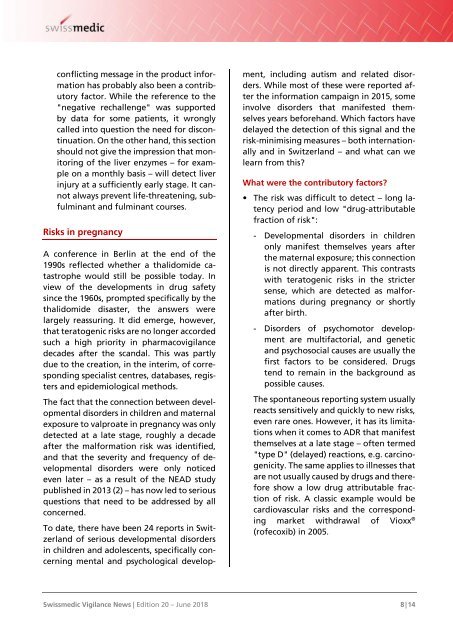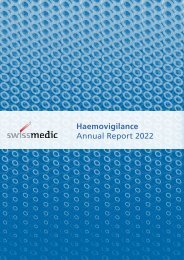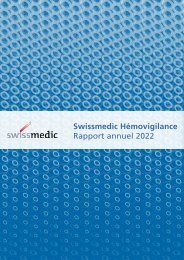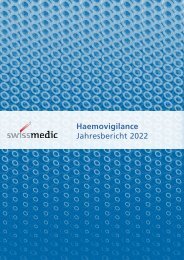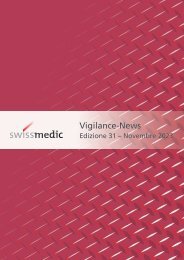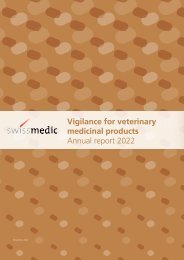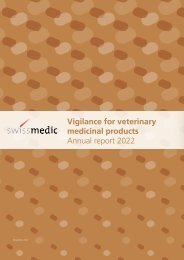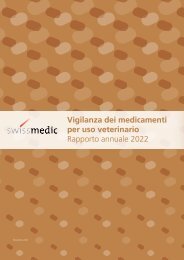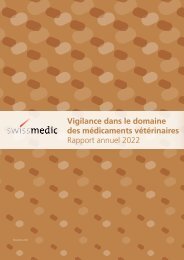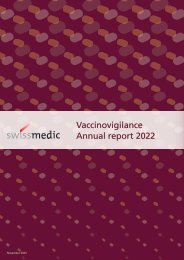Swissmedic Vigilance News Edition 20 – June 2018
Special issue: The history and development of pharma-covigilance in Switzerland over the last three decades
Special issue: The history and development of pharma-covigilance in Switzerland over the last three decades
Create successful ePaper yourself
Turn your PDF publications into a flip-book with our unique Google optimized e-Paper software.
conflicting message in the product information<br />
has probably also been a contributory<br />
factor. While the reference to the<br />
"negative rechallenge" was supported<br />
by data for some patients, it wrongly<br />
called into question the need for discontinuation.<br />
On the other hand, this section<br />
should not give the impression that monitoring<br />
of the liver enzymes <strong>–</strong> for example<br />
on a monthly basis <strong>–</strong> will detect liver<br />
injury at a sufficiently early stage. It cannot<br />
always prevent life-threatening, subfulminant<br />
and fulminant courses.<br />
Risks in pregnancy<br />
A conference in Berlin at the end of the<br />
1990s reflected whether a thalidomide catastrophe<br />
would still be possible today. In<br />
view of the developments in drug safety<br />
since the 1960s, prompted specifically by the<br />
thalidomide disaster, the answers were<br />
largely reassuring. It did emerge, however,<br />
that teratogenic risks are no longer accorded<br />
such a high priority in pharmacovigilance<br />
decades after the scandal. This was partly<br />
due to the creation, in the interim, of corresponding<br />
specialist centres, databases, registers<br />
and epidemiological methods.<br />
The fact that the connection between developmental<br />
disorders in children and maternal<br />
exposure to valproate in pregnancy was only<br />
detected at a late stage, roughly a decade<br />
after the malformation risk was identified,<br />
and that the severity and frequency of developmental<br />
disorders were only noticed<br />
even later <strong>–</strong> as a result of the NEAD study<br />
published in <strong>20</strong>13 (2) <strong>–</strong> has now led to serious<br />
questions that need to be addressed by all<br />
concerned.<br />
To date, there have been 24 reports in Switzerland<br />
of serious developmental disorders<br />
in children and adolescents, specifically concerning<br />
mental and psychological development,<br />
including autism and related disorders.<br />
While most of these were reported after<br />
the information campaign in <strong>20</strong>15, some<br />
involve disorders that manifested themselves<br />
years beforehand. Which factors have<br />
delayed the detection of this signal and the<br />
risk-minimising measures <strong>–</strong> both internationally<br />
and in Switzerland <strong>–</strong> and what can we<br />
learn from this?<br />
What were the contributory factors?<br />
• The risk was difficult to detect <strong>–</strong> long latency<br />
period and low "drug-attributable<br />
fraction of risk":<br />
- Developmental disorders in children<br />
only manifest themselves years after<br />
the maternal exposure; this connection<br />
is not directly apparent. This contrasts<br />
with teratogenic risks in the stricter<br />
sense, which are detected as malformations<br />
during pregnancy or shortly<br />
after birth.<br />
- Disorders of psychomotor development<br />
are multifactorial, and genetic<br />
and psychosocial causes are usually the<br />
first factors to be considered. Drugs<br />
tend to remain in the background as<br />
possible causes.<br />
The spontaneous reporting system usually<br />
reacts sensitively and quickly to new risks,<br />
even rare ones. However, it has its limitations<br />
when it comes to ADR that manifest<br />
themselves at a late stage <strong>–</strong> often termed<br />
"type D" (delayed) reactions, e.g. carcinogenicity.<br />
The same applies to illnesses that<br />
are not usually caused by drugs and therefore<br />
show a low drug attributable fraction<br />
of risk. A classic example would be<br />
cardiovascular risks and the corresponding<br />
market withdrawal of Vioxx ®<br />
(rofecoxib) in <strong>20</strong>05.<br />
<strong>Swissmedic</strong> <strong>Vigilance</strong> <strong>News</strong> | <strong>Edition</strong> <strong>20</strong> <strong>–</strong> <strong>June</strong> <strong>20</strong>18 8 | 14


